Managing Communication during Disasters: A Case Study of Flood Crisis in Queensland
VerifiedAdded on 2023/06/07
|8
|1545
|297
AI Summary
This report discusses the importance of managing communication during disasters and how it can help residents and businesses to move away from the disaster zone to remain healthy and safe. The case study involves the flood crisis that happened in January 2011 in Queensland, Australia. The report covers the overview of the situation, communication channels, recommendations, and references.
Contribute Materials
Your contribution can guide someone’s learning journey. Share your
documents today.
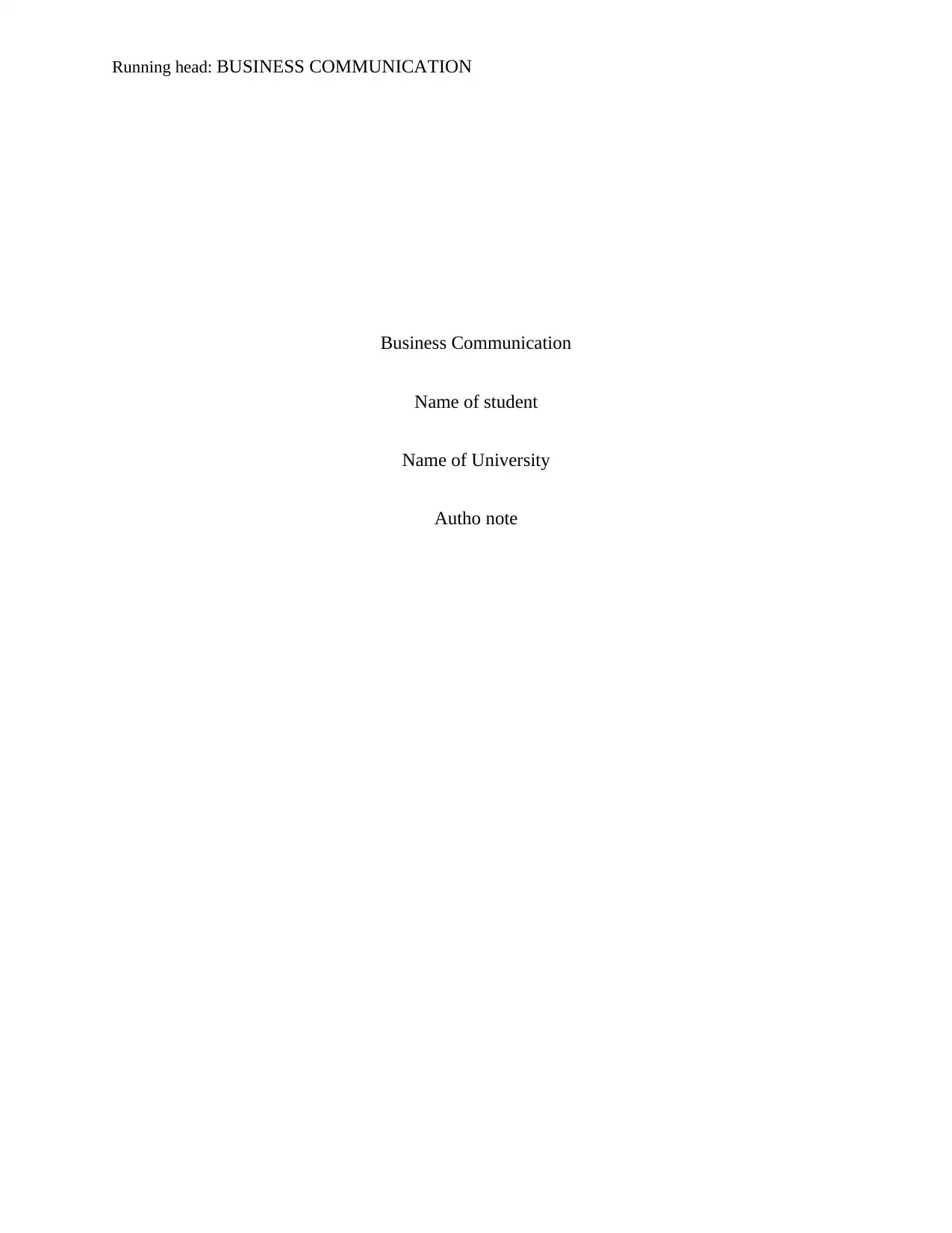
Running head: BUSINESS COMMUNICATION
Business Communication
Name of student
Name of University
Autho note
Business Communication
Name of student
Name of University
Autho note
Secure Best Marks with AI Grader
Need help grading? Try our AI Grader for instant feedback on your assignments.
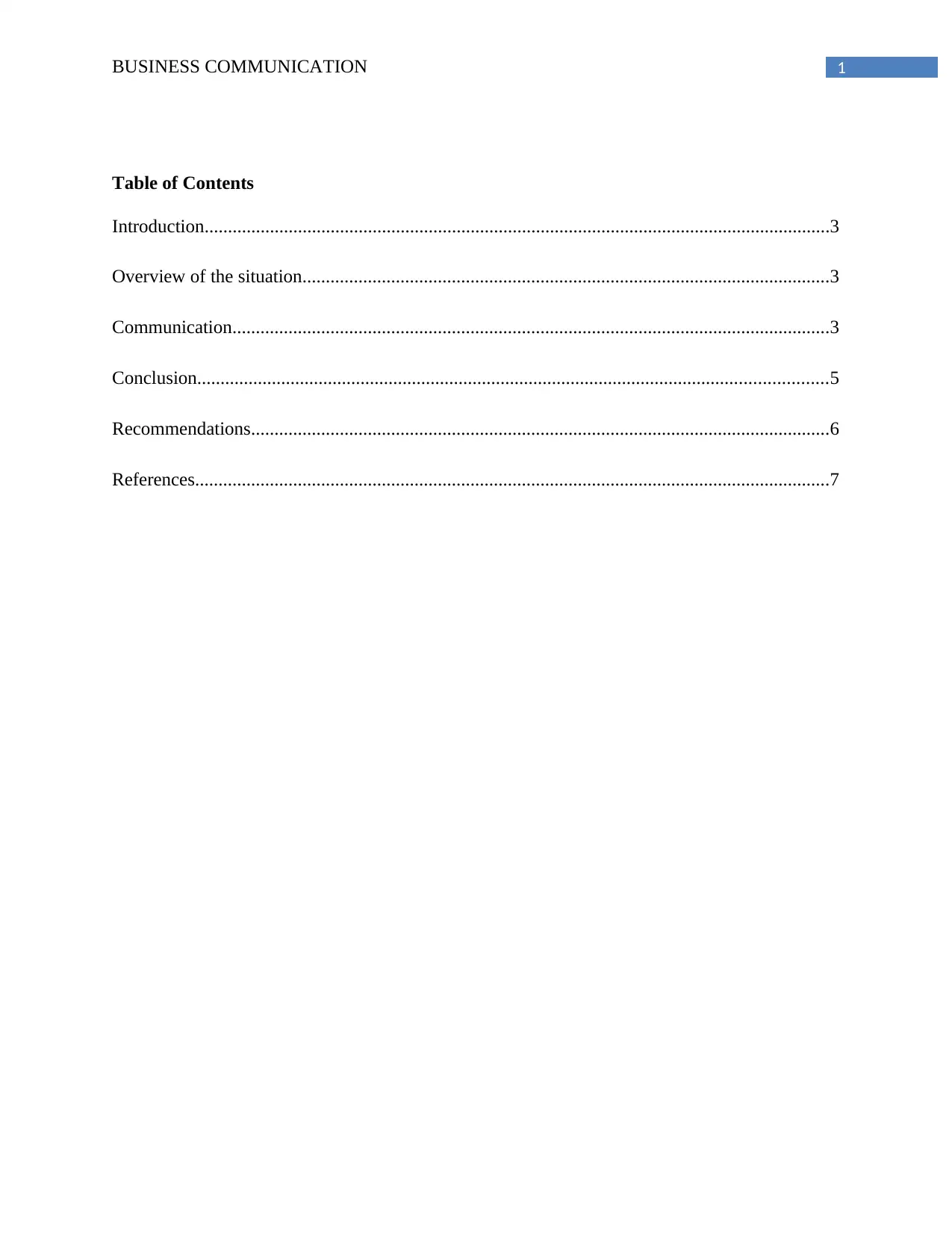
1BUSINESS COMMUNICATION
Table of Contents
Introduction......................................................................................................................................3
Overview of the situation.................................................................................................................3
Communication................................................................................................................................3
Conclusion.......................................................................................................................................5
Recommendations............................................................................................................................6
References........................................................................................................................................7
Table of Contents
Introduction......................................................................................................................................3
Overview of the situation.................................................................................................................3
Communication................................................................................................................................3
Conclusion.......................................................................................................................................5
Recommendations............................................................................................................................6
References........................................................................................................................................7
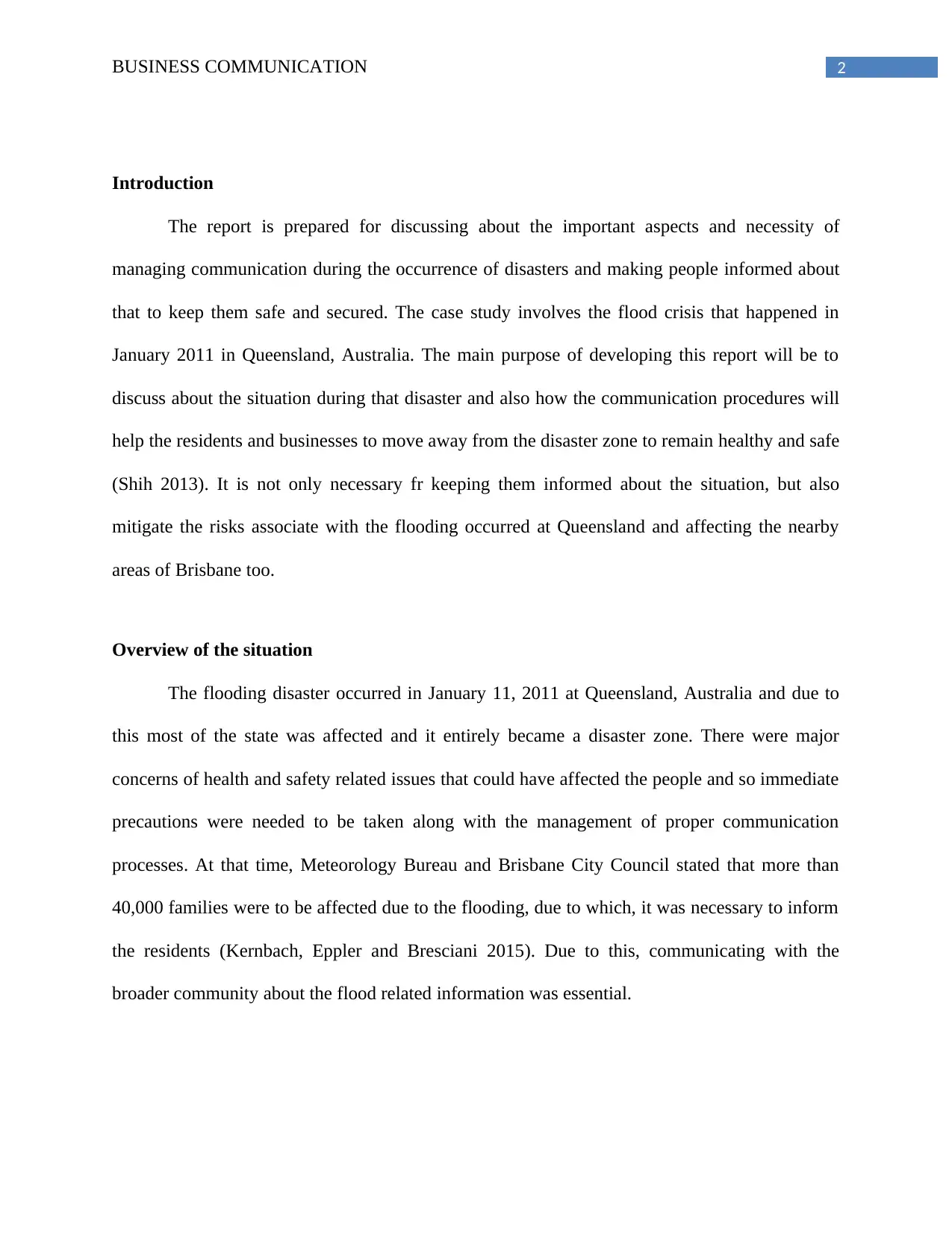
2BUSINESS COMMUNICATION
Introduction
The report is prepared for discussing about the important aspects and necessity of
managing communication during the occurrence of disasters and making people informed about
that to keep them safe and secured. The case study involves the flood crisis that happened in
January 2011 in Queensland, Australia. The main purpose of developing this report will be to
discuss about the situation during that disaster and also how the communication procedures will
help the residents and businesses to move away from the disaster zone to remain healthy and safe
(Shih 2013). It is not only necessary fr keeping them informed about the situation, but also
mitigate the risks associate with the flooding occurred at Queensland and affecting the nearby
areas of Brisbane too.
Overview of the situation
The flooding disaster occurred in January 11, 2011 at Queensland, Australia and due to
this most of the state was affected and it entirely became a disaster zone. There were major
concerns of health and safety related issues that could have affected the people and so immediate
precautions were needed to be taken along with the management of proper communication
processes. At that time, Meteorology Bureau and Brisbane City Council stated that more than
40,000 families were to be affected due to the flooding, due to which, it was necessary to inform
the residents (Kernbach, Eppler and Bresciani 2015). Due to this, communicating with the
broader community about the flood related information was essential.
Introduction
The report is prepared for discussing about the important aspects and necessity of
managing communication during the occurrence of disasters and making people informed about
that to keep them safe and secured. The case study involves the flood crisis that happened in
January 2011 in Queensland, Australia. The main purpose of developing this report will be to
discuss about the situation during that disaster and also how the communication procedures will
help the residents and businesses to move away from the disaster zone to remain healthy and safe
(Shih 2013). It is not only necessary fr keeping them informed about the situation, but also
mitigate the risks associate with the flooding occurred at Queensland and affecting the nearby
areas of Brisbane too.
Overview of the situation
The flooding disaster occurred in January 11, 2011 at Queensland, Australia and due to
this most of the state was affected and it entirely became a disaster zone. There were major
concerns of health and safety related issues that could have affected the people and so immediate
precautions were needed to be taken along with the management of proper communication
processes. At that time, Meteorology Bureau and Brisbane City Council stated that more than
40,000 families were to be affected due to the flooding, due to which, it was necessary to inform
the residents (Kernbach, Eppler and Bresciani 2015). Due to this, communicating with the
broader community about the flood related information was essential.
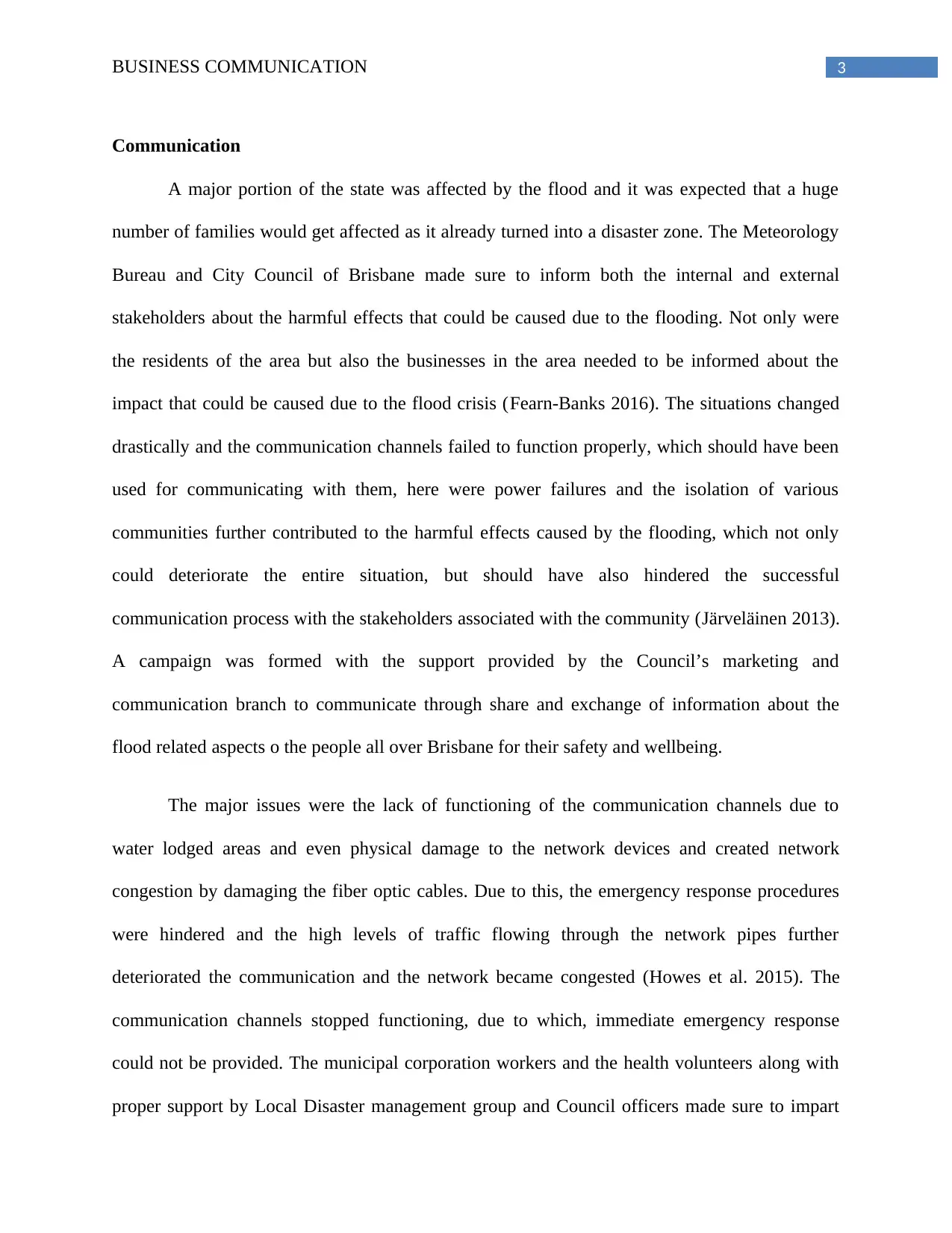
3BUSINESS COMMUNICATION
Communication
A major portion of the state was affected by the flood and it was expected that a huge
number of families would get affected as it already turned into a disaster zone. The Meteorology
Bureau and City Council of Brisbane made sure to inform both the internal and external
stakeholders about the harmful effects that could be caused due to the flooding. Not only were
the residents of the area but also the businesses in the area needed to be informed about the
impact that could be caused due to the flood crisis (Fearn-Banks 2016). The situations changed
drastically and the communication channels failed to function properly, which should have been
used for communicating with them, here were power failures and the isolation of various
communities further contributed to the harmful effects caused by the flooding, which not only
could deteriorate the entire situation, but should have also hindered the successful
communication process with the stakeholders associated with the community (Järveläinen 2013).
A campaign was formed with the support provided by the Council’s marketing and
communication branch to communicate through share and exchange of information about the
flood related aspects o the people all over Brisbane for their safety and wellbeing.
The major issues were the lack of functioning of the communication channels due to
water lodged areas and even physical damage to the network devices and created network
congestion by damaging the fiber optic cables. Due to this, the emergency response procedures
were hindered and the high levels of traffic flowing through the network pipes further
deteriorated the communication and the network became congested (Howes et al. 2015). The
communication channels stopped functioning, due to which, immediate emergency response
could not be provided. The municipal corporation workers and the health volunteers along with
proper support by Local Disaster management group and Council officers made sure to impart
Communication
A major portion of the state was affected by the flood and it was expected that a huge
number of families would get affected as it already turned into a disaster zone. The Meteorology
Bureau and City Council of Brisbane made sure to inform both the internal and external
stakeholders about the harmful effects that could be caused due to the flooding. Not only were
the residents of the area but also the businesses in the area needed to be informed about the
impact that could be caused due to the flood crisis (Fearn-Banks 2016). The situations changed
drastically and the communication channels failed to function properly, which should have been
used for communicating with them, here were power failures and the isolation of various
communities further contributed to the harmful effects caused by the flooding, which not only
could deteriorate the entire situation, but should have also hindered the successful
communication process with the stakeholders associated with the community (Järveläinen 2013).
A campaign was formed with the support provided by the Council’s marketing and
communication branch to communicate through share and exchange of information about the
flood related aspects o the people all over Brisbane for their safety and wellbeing.
The major issues were the lack of functioning of the communication channels due to
water lodged areas and even physical damage to the network devices and created network
congestion by damaging the fiber optic cables. Due to this, the emergency response procedures
were hindered and the high levels of traffic flowing through the network pipes further
deteriorated the communication and the network became congested (Howes et al. 2015). The
communication channels stopped functioning, due to which, immediate emergency response
could not be provided. The municipal corporation workers and the health volunteers along with
proper support by Local Disaster management group and Council officers made sure to impart
Secure Best Marks with AI Grader
Need help grading? Try our AI Grader for instant feedback on your assignments.
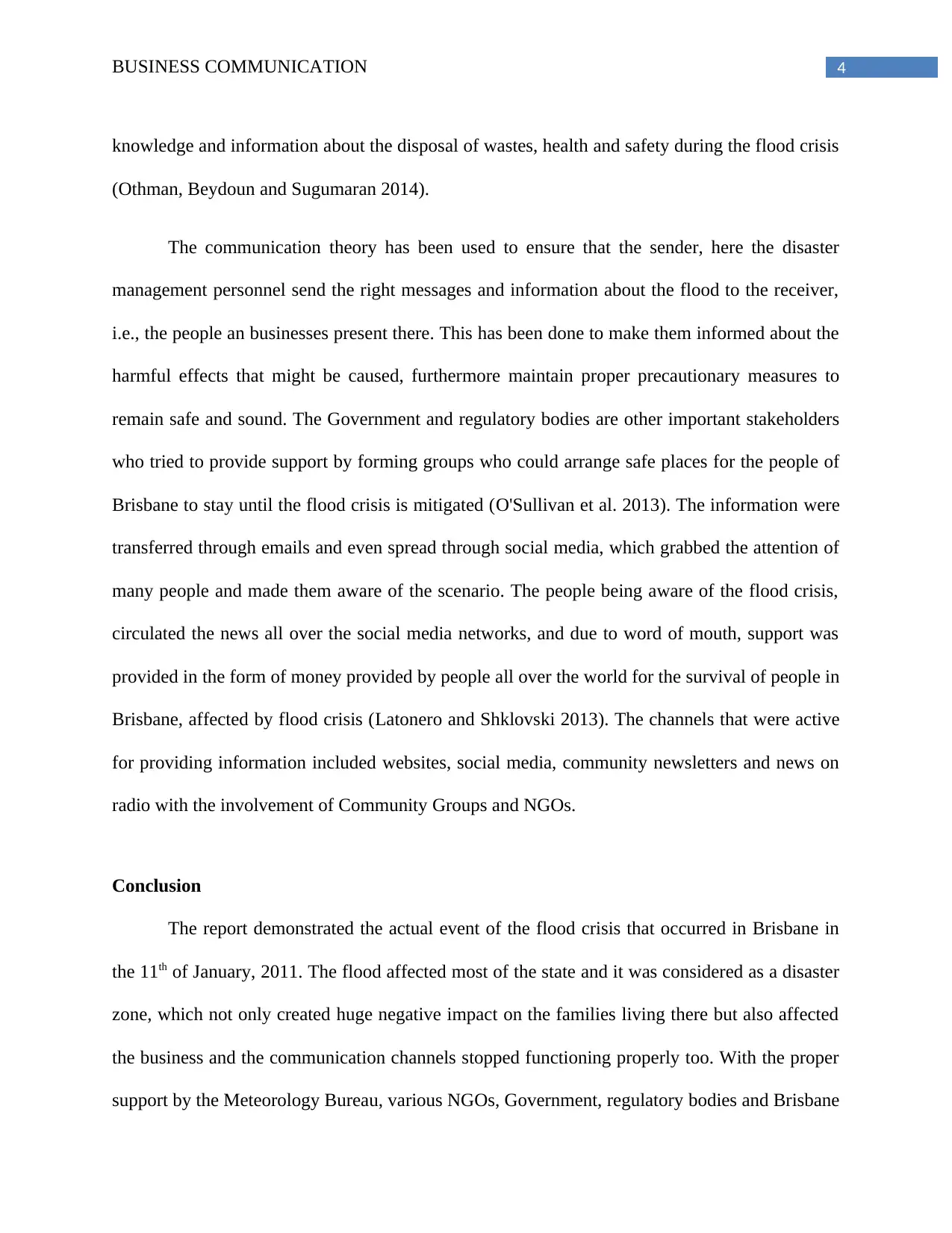
4BUSINESS COMMUNICATION
knowledge and information about the disposal of wastes, health and safety during the flood crisis
(Othman, Beydoun and Sugumaran 2014).
The communication theory has been used to ensure that the sender, here the disaster
management personnel send the right messages and information about the flood to the receiver,
i.e., the people an businesses present there. This has been done to make them informed about the
harmful effects that might be caused, furthermore maintain proper precautionary measures to
remain safe and sound. The Government and regulatory bodies are other important stakeholders
who tried to provide support by forming groups who could arrange safe places for the people of
Brisbane to stay until the flood crisis is mitigated (O'Sullivan et al. 2013). The information were
transferred through emails and even spread through social media, which grabbed the attention of
many people and made them aware of the scenario. The people being aware of the flood crisis,
circulated the news all over the social media networks, and due to word of mouth, support was
provided in the form of money provided by people all over the world for the survival of people in
Brisbane, affected by flood crisis (Latonero and Shklovski 2013). The channels that were active
for providing information included websites, social media, community newsletters and news on
radio with the involvement of Community Groups and NGOs.
Conclusion
The report demonstrated the actual event of the flood crisis that occurred in Brisbane in
the 11th of January, 2011. The flood affected most of the state and it was considered as a disaster
zone, which not only created huge negative impact on the families living there but also affected
the business and the communication channels stopped functioning properly too. With the proper
support by the Meteorology Bureau, various NGOs, Government, regulatory bodies and Brisbane
knowledge and information about the disposal of wastes, health and safety during the flood crisis
(Othman, Beydoun and Sugumaran 2014).
The communication theory has been used to ensure that the sender, here the disaster
management personnel send the right messages and information about the flood to the receiver,
i.e., the people an businesses present there. This has been done to make them informed about the
harmful effects that might be caused, furthermore maintain proper precautionary measures to
remain safe and sound. The Government and regulatory bodies are other important stakeholders
who tried to provide support by forming groups who could arrange safe places for the people of
Brisbane to stay until the flood crisis is mitigated (O'Sullivan et al. 2013). The information were
transferred through emails and even spread through social media, which grabbed the attention of
many people and made them aware of the scenario. The people being aware of the flood crisis,
circulated the news all over the social media networks, and due to word of mouth, support was
provided in the form of money provided by people all over the world for the survival of people in
Brisbane, affected by flood crisis (Latonero and Shklovski 2013). The channels that were active
for providing information included websites, social media, community newsletters and news on
radio with the involvement of Community Groups and NGOs.
Conclusion
The report demonstrated the actual event of the flood crisis that occurred in Brisbane in
the 11th of January, 2011. The flood affected most of the state and it was considered as a disaster
zone, which not only created huge negative impact on the families living there but also affected
the business and the communication channels stopped functioning properly too. With the proper
support by the Meteorology Bureau, various NGOs, Government, regulatory bodies and Brisbane
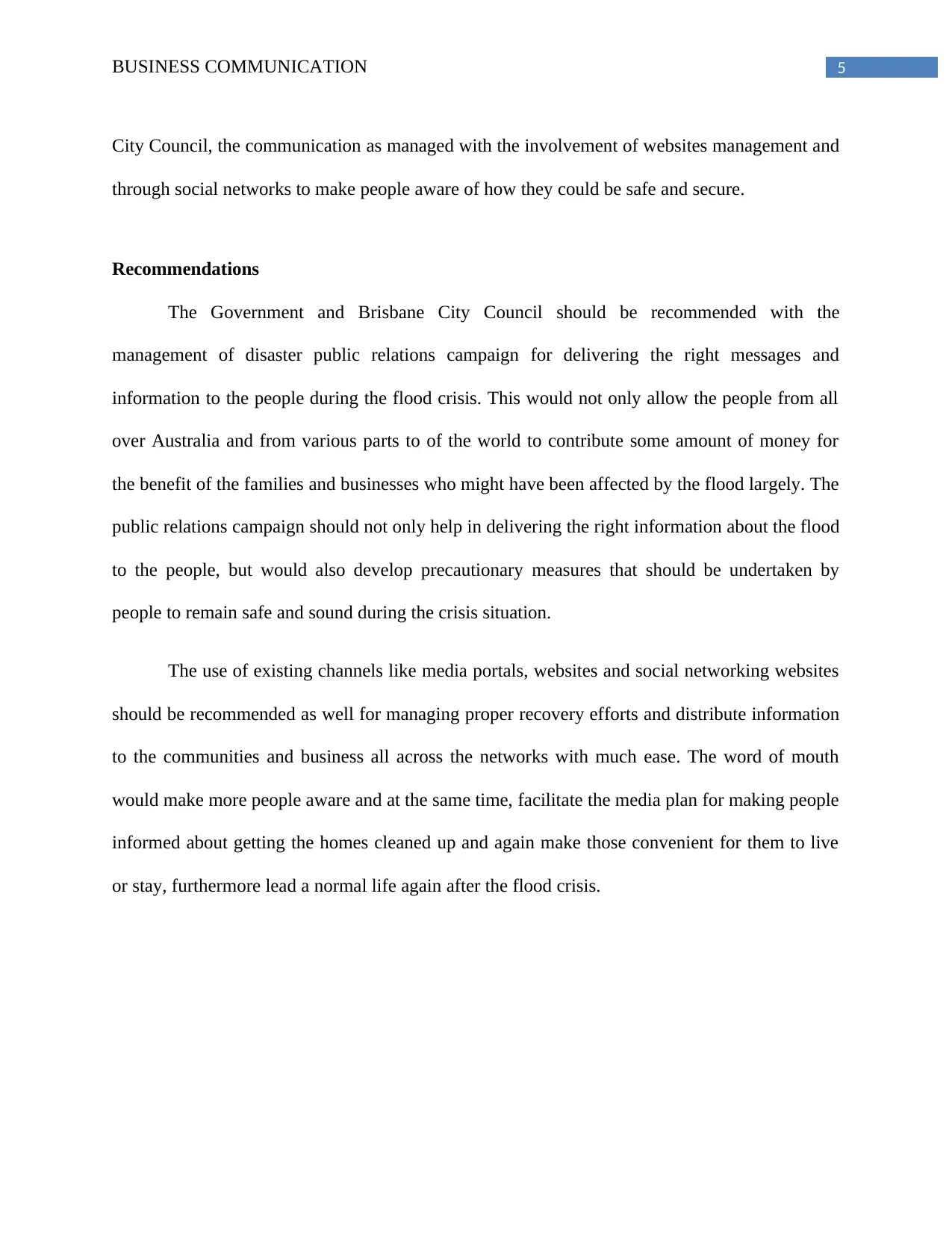
5BUSINESS COMMUNICATION
City Council, the communication as managed with the involvement of websites management and
through social networks to make people aware of how they could be safe and secure.
Recommendations
The Government and Brisbane City Council should be recommended with the
management of disaster public relations campaign for delivering the right messages and
information to the people during the flood crisis. This would not only allow the people from all
over Australia and from various parts to of the world to contribute some amount of money for
the benefit of the families and businesses who might have been affected by the flood largely. The
public relations campaign should not only help in delivering the right information about the flood
to the people, but would also develop precautionary measures that should be undertaken by
people to remain safe and sound during the crisis situation.
The use of existing channels like media portals, websites and social networking websites
should be recommended as well for managing proper recovery efforts and distribute information
to the communities and business all across the networks with much ease. The word of mouth
would make more people aware and at the same time, facilitate the media plan for making people
informed about getting the homes cleaned up and again make those convenient for them to live
or stay, furthermore lead a normal life again after the flood crisis.
City Council, the communication as managed with the involvement of websites management and
through social networks to make people aware of how they could be safe and secure.
Recommendations
The Government and Brisbane City Council should be recommended with the
management of disaster public relations campaign for delivering the right messages and
information to the people during the flood crisis. This would not only allow the people from all
over Australia and from various parts to of the world to contribute some amount of money for
the benefit of the families and businesses who might have been affected by the flood largely. The
public relations campaign should not only help in delivering the right information about the flood
to the people, but would also develop precautionary measures that should be undertaken by
people to remain safe and sound during the crisis situation.
The use of existing channels like media portals, websites and social networking websites
should be recommended as well for managing proper recovery efforts and distribute information
to the communities and business all across the networks with much ease. The word of mouth
would make more people aware and at the same time, facilitate the media plan for making people
informed about getting the homes cleaned up and again make those convenient for them to live
or stay, furthermore lead a normal life again after the flood crisis.

6BUSINESS COMMUNICATION
References
Fearn-Banks, K., 2016. Crisis communications: A casebook approach. Routledge.
Howes, M., Tangney, P., Reis, K., Grant-Smith, D., Heazle, M., Bosomworth, K. and Burton, P.,
2015. Towards networked governance: Improving interagency communication and collaboration
for disaster risk management and climate change adaptation in Australia. Journal of
environmental planning and management, 58(5), pp.757-776.
Järveläinen, J., 2013. IT incidents and business impacts: Validating a framework for continuity
management in information systems. International journal of information management, 33(3),
pp.583-590.
Kernbach, S., Eppler, M.J. and Bresciani, S., 2015. The use of visualization in the
communication of business strategies: An experimental evaluation. International Journal of
Business Communication, 52(2), pp.164-187.
Latonero, M. and Shklovski, I., 2013. Emergency management, Twitter, and social media
evangelism. In Using Social and Information Technologies for Disaster and Crisis
Management (pp. 196-212). IGI Global.
O'Sullivan, T.L., Kuziemsky, C.E., Toal-Sullivan, D. and Corneil, W., 2013. Unraveling the
complexities of disaster management: A framework for critical social infrastructure to promote
population health and resilience. Social Science & Medicine, 93, pp.238-246.
Othman, S.H., Beydoun, G. and Sugumaran, V., 2014. Development and validation of a Disaster
Management Metamodel (DMM). Information Processing & Management, 50(2), pp.235-271.
References
Fearn-Banks, K., 2016. Crisis communications: A casebook approach. Routledge.
Howes, M., Tangney, P., Reis, K., Grant-Smith, D., Heazle, M., Bosomworth, K. and Burton, P.,
2015. Towards networked governance: Improving interagency communication and collaboration
for disaster risk management and climate change adaptation in Australia. Journal of
environmental planning and management, 58(5), pp.757-776.
Järveläinen, J., 2013. IT incidents and business impacts: Validating a framework for continuity
management in information systems. International journal of information management, 33(3),
pp.583-590.
Kernbach, S., Eppler, M.J. and Bresciani, S., 2015. The use of visualization in the
communication of business strategies: An experimental evaluation. International Journal of
Business Communication, 52(2), pp.164-187.
Latonero, M. and Shklovski, I., 2013. Emergency management, Twitter, and social media
evangelism. In Using Social and Information Technologies for Disaster and Crisis
Management (pp. 196-212). IGI Global.
O'Sullivan, T.L., Kuziemsky, C.E., Toal-Sullivan, D. and Corneil, W., 2013. Unraveling the
complexities of disaster management: A framework for critical social infrastructure to promote
population health and resilience. Social Science & Medicine, 93, pp.238-246.
Othman, S.H., Beydoun, G. and Sugumaran, V., 2014. Development and validation of a Disaster
Management Metamodel (DMM). Information Processing & Management, 50(2), pp.235-271.
Paraphrase This Document
Need a fresh take? Get an instant paraphrase of this document with our AI Paraphraser

7BUSINESS COMMUNICATION
Shih, R.C., 2013. Effect of using Facebook to assist English for business communication course
instruction. Turkish Online Journal of Educational Technology-TOJET, 12(1), pp.52-59.
Shih, R.C., 2013. Effect of using Facebook to assist English for business communication course
instruction. Turkish Online Journal of Educational Technology-TOJET, 12(1), pp.52-59.
1 out of 8
Related Documents
Your All-in-One AI-Powered Toolkit for Academic Success.
+13062052269
info@desklib.com
Available 24*7 on WhatsApp / Email
![[object Object]](/_next/static/media/star-bottom.7253800d.svg)
Unlock your academic potential
© 2024 | Zucol Services PVT LTD | All rights reserved.




